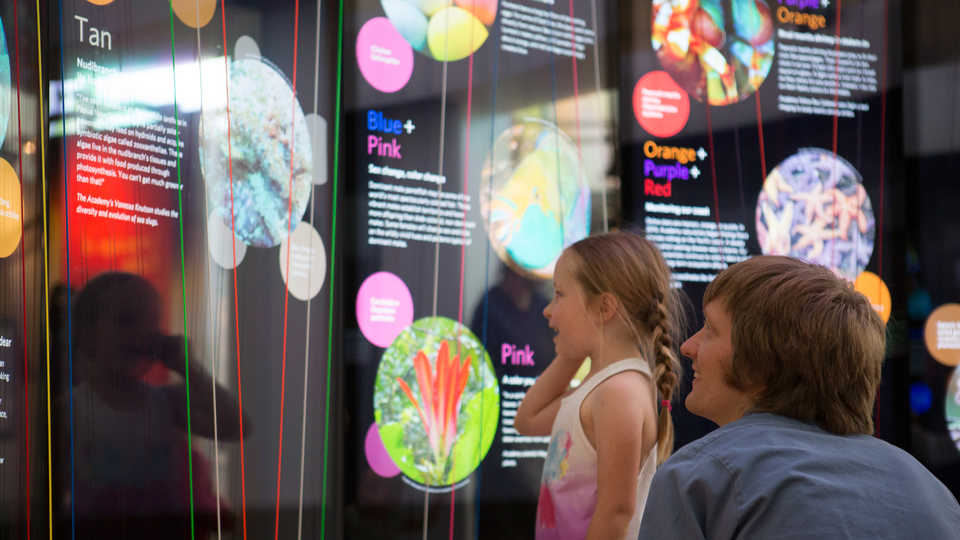Live animals and immersive interactives illustrate the fascinating role of color in nature in this major new exhibit.

San Francisco (February 27, 2015)—There’s more to color than meets the eye, and this summer, visitors to the California Academy of Sciences will discover nature’s secret language in Color of Life, a major new exhibit opening June 12, 2015. Made possible through a generous gift from Google.org, vibrant live animals, shimmering scientific specimens, and immersive interactives invite visitors to touch, see, and experience the often surprising ways that nature’s colors help us understand the health of ecosystems and the interconnectedness of life on Earth.
“Through the wonder of color, we aim to inspire Academy visitors to understand and appreciate the diverse living systems we all depend on,” says Dr. Jon Foley, the Academy’s Executive Director. “At a time when the planet’s biodiversity and environments are in significant decline, we hope Color of Life will offer a new perspective on the natural world—using color as a lens to explore, explain, and sustain our planet. We are thrilled to have Google.org’s generous support of this wonderful exhibit.”
Visualizing color
Upon entering the 8,000 sq. ft. exhibit, visitors will find themselves immersed in a color-rich, multisensory space filled with eye-popping visuals at every turn. At the center of the exhibit, an interactive color visualizer surfaces surprising examples of how species use color to communicate and survive. By plucking an array of multi-colored strings, visitors can explore over 100 unique color stories as vibrant images and short videos appear on a screen before them. Strum a red cord, for example, and learn how a male cardinal bird colors his vibrant red feathers with pigments from food. Without a diet rich in red and yellow pigments, his vibrantly colored plumage would fade with every molt. Strum a yellow cord and see just how a yellow leopard’s spotted coat allows this predator to stalk its prey and blend in with shadow and light while moving through tall grass.
By peering inside small dioramas within the exhibit, visitors will see how illuminated organisms like fireflies, mushrooms, and glowworms produce their own chemical light through bioluminescence and fluorescence. With high-resolution GIGAmacro imaging, visitors can also zoom in close to examine a colorful landscape of butterfly scales, leaf hairs, and colorful shells with incredible clarity. Additionally, cases and drawers of color filled with iridescent beetles, multi-colored fur, marine life, and flowering plants demonstrate how diverse organisms share a single color pigment. In a neighboring interactive, photo and video animations illuminate what we can learn from the Academy’s collection of nearly 46 million scientific specimens. Stories highlight a colorful range of organisms and showcase how collections help support species conservation; they also illustrate just how fleeting color can be.
Nature’s colorful cast
Throughout the exhibit, live animals will illustrate how color communicates, sending signals that can attract or repel. With their bold, color-blocked plumage, live Gouldian finches within an open aviary will showcase how color patterns can vary within a single species and how this dazzling distinction gives female birds a “heads up” when choosing a mate. A display of Riggenbach’s reed frogs, whose color patterns vary dramatically between males and females of the same species, demonstrate how bright colors often spark investigations into scientific mysteries.
“The remarkable but poorly understood differences in coloration between males and females of this and other species of African reed frogs underscore how little we know about so many amphibian species,” says Dr. David Blackburn, Associate Curator of Herpetology at the Academy. “Through ongoing collaboration between Academy research scientists and aquarium biologists, we’re able to gain new knowledge about species biology, behavior, and conservation, allowing us to study how and why the sexes of these species differ so much in color and pattern.”
While some animals use color as a form of visual advertising, other species rely on color in the form of camouflage to conceal themselves from potential predators. Rotating displays of giant green leaf-mimicking insects and color changing cephalopods—including octopuses and cuttlefish—will show how texture, pattern, and behavior all play an important role in concealing color. Blending in is one way that animals can avoid being eaten, but predators like pythons have a few tricks, too. Visitors can see how small, warm animals might look to a green tree python, which senses infrared or heat to track down prey at night.
Science through the lens of color
Through evocative visual storytelling, Academy scientists will share how color informs their own biodiversity research around the world, serving as an important indicator for ecosystem health and signaling habitats in need of protection. With stunning images and video from the field, visitors can dive below the ocean’s surface to view resilient coral reef ecosystems around the world and learn about conservation efforts that support healthy environmental restoration. While getting a bird’s eye view of treetop ecosystems teeming with biodiversity, visitors will learn how color—and life—varies between the forest floor and sky-high canopies.
The Academy will also launch a suite of color-focused programs and special events to support the Color of Life exhibit, including a special NightLife event, an opening weekend festival, an Educator Guide, and more.
Press Contacts
If you are a journalist and would like to receive Academy press releases please contact press@calacademy.org.
Digital Assets
Hi-res and low-res image downloads are available for editorial use. Contact us at press@calacademy.org to request access.